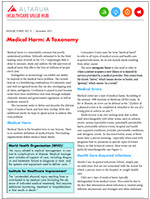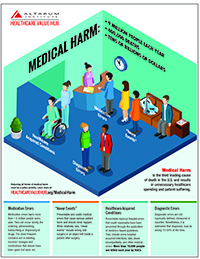Improving Value
Reducing Medical Harm - National Practitioner Data Bank
A critically important area of excess spending and patient suffering is connected to care that is not only unnecessary but actually harms patients. Among other things, medical harm includes:
- serious reportable events—more commonly called “never events;”1
- healthcare-acquired conditions (HACs);
- healthcare-acquired infections (HAIs);
- medication errors; and
- diagnostic errors.
The strategies that help reduce patient harm are fairly well-understood but unevenly implemented. Making the National Practitioner Data Bank (NPDB) reports available to the public is one policy tool to address patient medical harm and improve healthcare quality, increase patient confidence in our health system and reduce spending.
National Practitioner Data Bank
Congress created the NPDB in 1986 to keep practitioner medical malpractice and adverse actions information in one web-based place. The NPDB contains information about adverse action, medical malpractice payment and judgment or conviction reports connected to healthcare practitioners, providers and suppliers.2 The NPDB prevents practitioners from relocating to practice in a different state and avoiding discovery of poor performance records by their future employers.3 While there are concerns about the completeness of the data,4 the NPDB is the only relatively comprehensive national source for malpractice and medical disciplinary information.
The NPDB repository is only accessible to registered entities and is not publicly-accessible.5 Entities eligible for registration include hospitals, professional societies, Medicaid fraud control units, federal or state prosecutors and state and federal agencies.6
While it has been long debated,7 currently the general public does not have access to the NPDB or its reports, though individuals can request access to statistical data.8 Providing the public with access to the NPDB can promote transparency and offer consumers the opportunity to make informed decisions about their healthcare. Moreover -- similar to medical harm reporting -- making the NPDB publicly-accessible can incentivize hospitals and other healthcare providers to improve their performance. Worth noting, consumer9 use of publicly-accessible patient safety data is currently low. This could be due to the style in which public reports are presented. Specifically, the lack of standardization across measures and definitions of patient harm among reporting systems results in conflicting information that is often confusing to consumers. It is important that public reporting systems adopt standard definitions and measures of medical harm so that the information is useful to consumers.10
Publicizing NPDB data can reduce medical harm events when used with other strategies.
Notes
1. These errors are defined as "adverse events that are serious, largely preventable." A list of "never events" is maintained by the National Quality Forum.
2. "What is reported to the NPDB?" National Practitioner Data Bank.
3. "About Us," National Practitioner Data Bank.
4. Eiserer, Tanya, and Mark Smith, "'Dr. Death' Highlights Loopholes Putting Patients at Risk," WFAA (February 10, 2020).
5. "What is the NPDB?" National Practitioner Data Bank.
6. "What is an Eligible Entity?" National Practitioner Data Bank.
7. Barker Pape, Julie, "Physician Date Banks: The Public's Right to Know Versus the Physician's Right to Privacy," Fordham L. Review, Vol. 66, No. 3 (1997).
8. "Public Information," National Practitioner Data Bank.
9. Campanella, Paolo, et al., "The Impact of Public Reporting on Clinical Outcomes: A Systematic Review and Meta-Analysis," BMC Health Services Research, Vol. 16, No. 296 (July 2016).
10. James, Julia, "Public Reporting on Quality and Costs," Health Affairs (March 2012).








